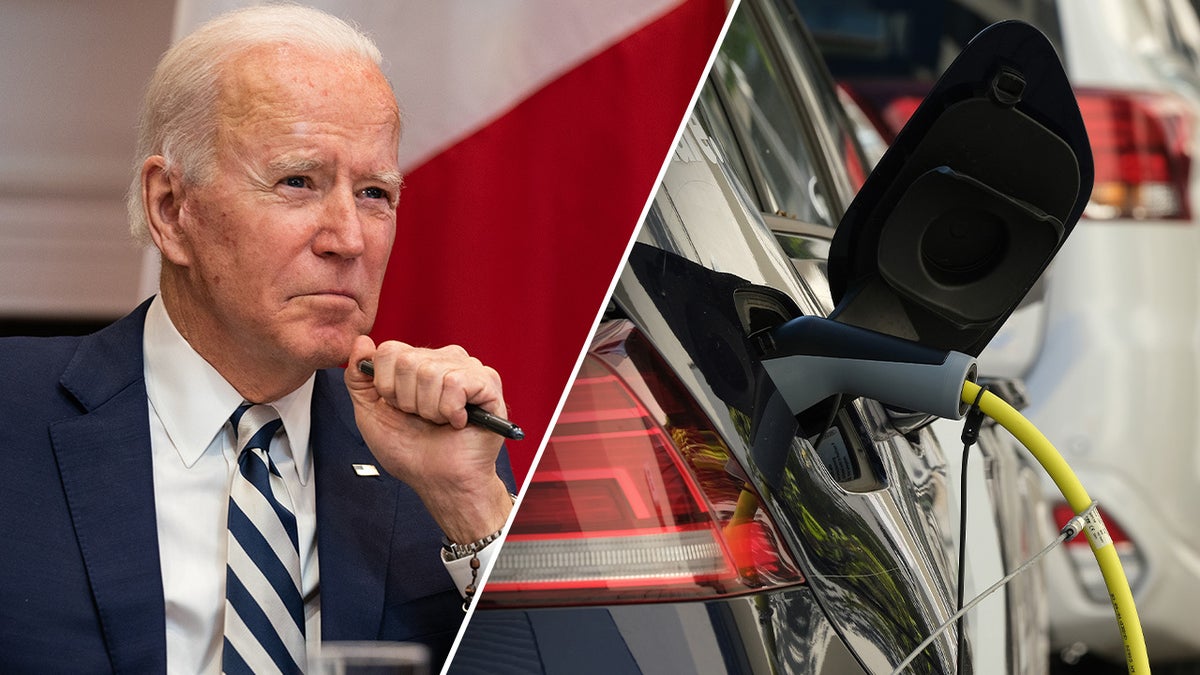California's EV Mandate: Automakers' Fierce Opposition

Table of Contents
California's ambitious electric vehicle (EV) mandate is creating significant waves within the automotive industry. This aggressive push towards zero-emission vehicles (ZEVs) by 2035 is encountering substantial resistance from major automakers, sparking a heated debate about its practicality, economic ramifications, and true environmental effectiveness. This article explores the core reasons behind the automakers' fierce opposition to California's EV mandate.
High Production Costs and Infrastructure Challenges
The transition to a predominantly electric vehicle fleet faces substantial hurdles related to production costs and inadequate infrastructure. These challenges form a significant part of automakers' opposition to California's aggressive timeline.
Battery Production Bottlenecks
The current demand for EV batteries far outstrips the supply chain's capacity, leading to skyrocketing costs. Several factors contribute to this bottleneck:
- Limited mining of critical minerals: The extraction of crucial minerals like lithium, cobalt, and nickel, essential for battery production, is geographically concentrated and faces environmental and geopolitical challenges. Securing a stable and ethical supply chain remains a major hurdle.
- Complex and expensive battery manufacturing processes: Manufacturing EV batteries is a complex and capital-intensive process, requiring specialized facilities and skilled labor, further contributing to high costs.
- Lack of sufficient battery recycling infrastructure: The absence of robust battery recycling programs adds to the environmental concerns and increases the reliance on new mineral extraction, impacting both cost and sustainability.
Inadequate Charging Infrastructure
Widespread EV adoption necessitates a comprehensive and readily available charging infrastructure. Currently, this infrastructure is insufficient, particularly in rural areas, creating a significant barrier to consumer adoption and fueling automakers' concerns:
- Insufficient public charging stations: The density of public charging stations, especially fast-charging stations, remains inadequate to support a large-scale transition to EVs.
- Uneven distribution of charging networks: Charging infrastructure is concentrated in urban areas, leaving rural communities underserved and hindering EV adoption in those regions.
- Concerns over charging speed and reliability: Charging times and the reliability of charging stations remain significant concerns for potential EV buyers, impacting consumer confidence and hindering wider adoption.
Consumer Demand and Affordability Concerns
Beyond the production and infrastructure challenges, automakers also highlight concerns regarding consumer demand and affordability as key reasons for their opposition to the California EV mandate.
High Purchase Prices of EVs
Electric vehicles typically command higher purchase prices compared to their gasoline-powered counterparts, creating a substantial barrier to entry for many consumers:
- Government incentives may not be sufficient for all buyers: While government incentives and tax credits aim to offset the higher purchase price, they may not be sufficient for all potential buyers, particularly those in lower-income brackets.
- Limited range and charging time are also deterrents for some: Concerns about limited driving range and longer refueling times compared to gasoline vehicles continue to deter some consumers from switching to EVs.
Consumer Preferences and Range Anxiety
Range anxiety – the fear of running out of battery charge before reaching a charging station – remains a major psychological barrier to EV adoption:
- Marketing and education campaigns needed to address consumer concerns: Comprehensive marketing and educational campaigns are needed to address consumer concerns regarding range anxiety and the overall practicality of EVs.
- Technological advancements needed to improve battery range and charging speeds: Further technological advancements in battery technology and charging infrastructure are crucial to alleviate range anxiety and boost consumer confidence.
Legal and Regulatory Hurdles
The California EV mandate also faces significant legal and regulatory challenges, further fueling automakers' opposition.
Challenges to California's Authority
Automakers are challenging the legal basis and preemptive nature of California's regulations, arguing that it infringes upon federal standards:
- Legal battles and lobbying efforts to influence federal regulations: Automakers are engaging in extensive legal battles and lobbying efforts to influence federal regulations and potentially weaken or overturn California's mandate.
- Potential for inconsistencies between state and federal standards: The potential for discrepancies between California's stringent standards and federal regulations creates uncertainty and complexities for automakers operating nationwide.
Compliance Costs and Regulatory Uncertainty
Meeting the stringent requirements of the EV mandate imposes substantial financial burdens on automakers, creating uncertainty in their business planning:
- Uncertainty surrounding future regulations and potential changes: The evolving regulatory landscape and the uncertainty surrounding future regulations contribute to the hesitancy of automakers to make significant investments in EV production.
- Significant investments required to transition production lines: Transitioning production lines to manufacture EVs requires massive investments in new equipment, technology, and workforce training, creating significant financial risk for automakers.
Conclusion
California's ambitious EV mandate, while aiming for cleaner air and reduced carbon emissions, faces considerable opposition from automakers due to cost concerns, inadequate infrastructure, and legal complexities surrounding the California Emission Standards. The success of this transition to zero-emission vehicles hinges on addressing these challenges through technological innovation, substantial investments in charging infrastructure, and clear, consistent regulations. Understanding the nuances of automakers' opposition to the California EV mandate is critical for navigating the future of the automotive industry and achieving a smooth clean energy transition. To remain informed on the evolving dynamics of the California EV mandate and its broader impact, continue monitoring news and analyses on this critical issue.

Featured Posts
-
 Mikto Orkoto Efeteio Dodekanisoy Leptomeris Analysi Toy Boyleymatos Kai Ton 210 Enorkon
May 19, 2025
Mikto Orkoto Efeteio Dodekanisoy Leptomeris Analysi Toy Boyleymatos Kai Ton 210 Enorkon
May 19, 2025 -
 Fa Cup Final Erling Haalands Goal Scoring Struggle Persists At Wembley
May 19, 2025
Fa Cup Final Erling Haalands Goal Scoring Struggle Persists At Wembley
May 19, 2025 -
 El Grupo Finlandes Que Cantara En Sueco En Eurovision Tras 27 Anos
May 19, 2025
El Grupo Finlandes Que Cantara En Sueco En Eurovision Tras 27 Anos
May 19, 2025 -
 Where To Watch Final Destination 5 Showtimes Streaming And Availability
May 19, 2025
Where To Watch Final Destination 5 Showtimes Streaming And Availability
May 19, 2025 -
 Moldova Vs Norway Haaland Stars In Convincing World Cup Qualifying Victory
May 19, 2025
Moldova Vs Norway Haaland Stars In Convincing World Cup Qualifying Victory
May 19, 2025
